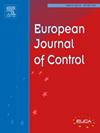Observer-based adaptive consensus of intelligent vehicle convoys with directed and undirected networks subject to input saturation
IF 2.6
3区 计算机科学
Q2 AUTOMATION & CONTROL SYSTEMS
引用次数: 0
Abstract
In this research work, the consensus control design of intelligent vehicle convoys with directed and undirected networks and third-order dynamic equation is studied. The engine saturation as an input saturation is involved in the dynamical model which will make the longitudinal dynamics of each following intelligent vehicle to be nonlinear. All followers track an actual leading intelligent vehicle that has no input. For some reasons such as reducing the communication burden, external attacks and sensor failure, it is assumed that some of the states of followers and the leader are not available. Three common network structures are considered in consensus design and analysis: some predecessors following, bi-directional and uni-directional. To estimate the inaccessible states of followers and the leader, two different observers combined with an output feedback controller are designed so that each follower can estimate its own and the leader's unknown states. Afterward, a linear output feedback law is introduced to attain the global asymptotic consensus. The Lyapunov theory is applied to prove that the output control protocol leads the proposed intended convoy to asymptotic stability in the linear and nonlinear input saturation regions. For all three structures, several examples are provided to evaluate the method of this article.
输入饱和下有向和无向网络智能车队的观测器自适应共识
研究了具有有向网络和无向网络以及三阶动力学方程的智能车辆车队的共识控制设计问题。发动机饱和度作为输入饱和度被纳入到动力学模型中,这将使跟随的每辆智能车的纵向动力学成为非线性的。所有追随者都跟踪一辆没有输入的实际领先智能车辆。出于减轻通信负担、外部攻击和传感器故障等原因,假设follower和leader的某些状态不可用。在共识设计和分析中,考虑了三种常见的网络结构:一些前沿性的、双向的和单向的。为了估计follower和leader的不可达状态,设计了两个不同的观测器和一个输出反馈控制器,使得每个follower都可以估计自己和leader的未知状态。然后,引入线性输出反馈律,得到全局渐近共识。应用李雅普诺夫理论证明了输出控制协议在线性和非线性输入饱和区域使所提出的目标车队趋于渐近稳定。对于这三种结构,提供了几个示例来评估本文的方法。
本文章由计算机程序翻译,如有差异,请以英文原文为准。
求助全文
约1分钟内获得全文
求助全文
来源期刊

European Journal of Control
工程技术-自动化与控制系统
CiteScore
5.80
自引率
5.90%
发文量
131
审稿时长
1 months
期刊介绍:
The European Control Association (EUCA) has among its objectives to promote the development of the discipline. Apart from the European Control Conferences, the European Journal of Control is the Association''s main channel for the dissemination of important contributions in the field.
The aim of the Journal is to publish high quality papers on the theory and practice of control and systems engineering.
The scope of the Journal will be wide and cover all aspects of the discipline including methodologies, techniques and applications.
Research in control and systems engineering is necessary to develop new concepts and tools which enhance our understanding and improve our ability to design and implement high performance control systems. Submitted papers should stress the practical motivations and relevance of their results.
The design and implementation of a successful control system requires the use of a range of techniques:
Modelling
Robustness Analysis
Identification
Optimization
Control Law Design
Numerical analysis
Fault Detection, and so on.
 求助内容:
求助内容: 应助结果提醒方式:
应助结果提醒方式:


